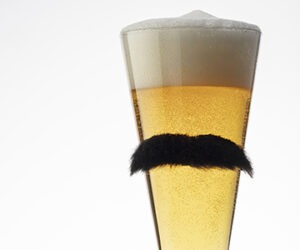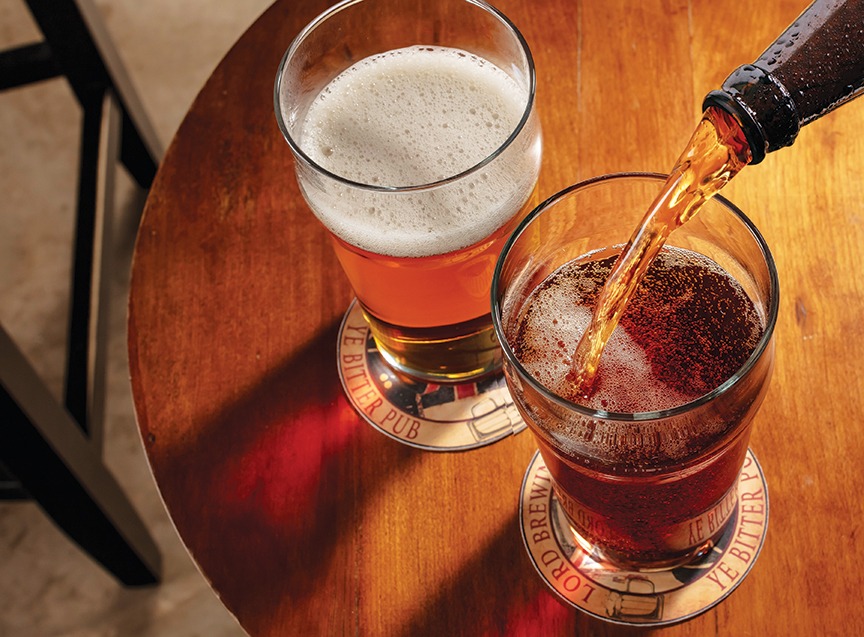Hot Rocks! Making a Stein Beer
Homebrewers spend lots of time pondering the merits of certain beer styles. Should they brew a brown ale or a pale ale, a pilsner or a helles? But in the early days of brewing, brewers were much more concerned with method than style. Heating the water and boiling the wort were probably the greatest obstacle to making a decent beer. How in the heck were you supposed to brew without the modern conveniences of steam jackets or direct heat? For brewers in the Middle Ages, hot rocks were the most logical means of conducting heat. When dropped in a wooden vat filled with wort, the heated rocks had a cauldron effect, causing the wort to boil vigorously over a period of several minutes. This resulting brew became known as “stein beer.”
From the name – “stein” is German for “stone” – we can gather that Germans developed this traditional brewing method. Stein beer was most common in the Alpine regions of Europe, where stones were easily quarried and transported back to the brewery. With the Industrial Revolution came easier means of heating wort, and by the start of the 20th century, the method was obsolete.
Stein beer might have been forgotten had not Rauchenfels revived the technique in 1982. Located in Marktoberdorf, Bavaria, Rauchenfels is the original stein-beer brewery of the modern era. The brewers use “graywacke,” a dark sandstone that resists shattering under superhot temperatures.
Homebrewers take note: Stein beer is all about a brewing method, not about a style. Any beer can be a stein beer, as long as you use rocks in the brewing process!
Rocks and Wood
From start to finish, everything about making stein beer is just like any of your favorite brews. The only twist is how you boil the wort.
First: You’ll need some rocks. Granite rocks are the only choice for homebrewers, since they can be superheated in a high-temperature fire. Other types of stones, like sedimentary rocks, might explode as the temperature rises. Local quarries are a good place to procure rocks, or try your favorite gardening store.
The size of your rocks will depend on your boiling vessel. Obviously, they must easily fit inside the kettle. More important, though, is that they do not displace too much of the wort (thus leading to a major boilover). Fist-sized granite stones are a good choice for homebrewers. Not only do they complement the size of an average home brewery, they also heat faster and are easily transported from the fire to the kettle. You should acquire 10 to 15 rocks of this size.
For a fire, good hardwood is the best choice. Hardwood burns hot and long, and it also gives subtle flavors to the stone. This will be imparted to the wort when you immerse the stones. Cherry and oak are two types of wood that burn well and add flavor to your brew.
Once you have a red-hot bed of coals, about one-inch deep or more, use long, well-insulated metal tongs to place the rocks in the fire. (Note: You must be extremely careful!) Cover the rocks with coals. The rocks will start to “glow” after a little while, turning somewhat red as they heat up. When they turn white they have become superheated.
Use the tongs to extract 3 or 4 rocks from the fire. Place the rocks in a stainless-steel colander and, using an insulated tong to grab each handle, place the colander in the wort. Almost immediately, your wort will rise to a boil. After about ten minutes, that boil will fade. Remove the colander and place the “cool” rocks back in the fire.
You should have left some rocks in the fire. These will be superheated. Repeat the process, placing these new “hot rocks” in the colander and then in the beer. Over the course of at least one hour, you will rotate the rocks from the fire to the brew kettle, always keeping the wort at or near a
constant boil.
As you come to the end of the boil, start setting your “cool” rocks aside in a container (sterilized, if possible). You will use these again during secondary fermentation.
Creating a Recipe
Recipes for the stein-beer method vary widely. Many homebrewers will insist on brewing a lager. This is the German tradition, after all! Remember, though, that Germans also enjoy the occasional ale: kölsch, altbier and hefeweizen are three examples. Why not tack stein beer onto that list?
That’s why I chose an ale yeast strain. I like the English Ale Yeast by White Labs (WLP002) because it is highly flocculant. It also leaves a nice residual sweetness and ferments well between 65° to 68° F, which are much easier temperatures for the average homebrewer to maintain.
My malt bill produces a light copper color. The heavy use of Munich (which makes up 50 percent of the malt bill) will result in a very malty palate. Another 45 percent of the malt bill is pale malt. Crystal malt is the remaining 5 percent. This adds some color and body.
I also bumped up the malt content, figuring that some fermentable sugars are going to be lost each time I submerge new, superheated rocks in the wort. Why? Because a portion of the sugar will caramelize and solidify against the rocks. This sugar will be lost for fermentation purposes. For this reason, my preference is to “shoot high” with the malt bill.
At the end of the lauter and the sparge, test the wort for a baseline specific gravity reading. Then, throughout the process of boiling with the rocks, keep checking it. Stop when you get a reading of around 1.055. One thing to remember: While specific gravity will be rising as you boil, I have found that caramelization can also cause it to temporarily fall. (As sugar sticks to the rocks, there is less sugar in the water, which causes the specific gravity to drop … until that water is boiled away.) Balancing out these opposing forces is the key to hitting your recipe’s gravity targets.
Another note: When you take wort samples, you will need to rapidly reduce the temperature of the sample to around 65° to 70° F to get an accurate specific gravity reading. A good way to do this is to spin the sample rapidly in an ice water bath. Use heavy plastic or metal for the sample, as glass may crack due to the rapid temperature change. After spinning for several minutes, the wort will drop to the right temperature.
I kept the bitterness very low, shooting roughly for 20 to 25 IBUs. Hop flavor and aroma is practically nonexistent. I’m looking for a finished beer that is malty in texture and flavor, with bitterness only to round out the palate.
Beyond the use of rocks to boil your brew, they also come in handy during secondary fermentation. You will notice that the rocks have been coated with a hard, malty residue. This occurred when you added the superheated rocks to the wort and a portion of the malt sugars caramelized against the stone.
Before transferring the beer to a secondary fermenter, place several of the caramelized rocks inside (you need a bucket to do this). Then rack the beer on top of the rocks. You may experience slight secondary fermentation from remnant sugars. Mostly, though, the rocks will just impart additional flavor.
Stonehenge Stein Beer
(5 gallons, all-grain)
Ingredients:
- 5.5 lbs. Munich malt
- 5 lbs. American two-row malt
- 0.5 lbs. crystal malt (40° Lovibond)
- 5 AAU Hallertauer hops (1 oz. of 5% alpha acid)
- Starter of White Labs English Ale yeast (WLP002)
- 3/4 cup corn sugar for priming
Step by Step:
Start hardwood fire in a large grill. Spread the hot coals out to form a bed at least one-inch deep. Place the granite rocks in the coals.
As the rocks are heating, mash grains in 2.5 gal. water in a single infusion at 150° F for 60 min. or until iodine test is negative. Sparge with 170° F water to collect 6 gal.
When all the wort is collected in the boiling vessel, remove 3 to 5 superheated rocks from the fire. Use a heat-resistant barbecue-type brush to flick any embers from the rocks. Place the rocks in a stainless-steel colander and submerge them in the wort. Repeat this process for the entire boiling period.
At start of boil, add Hallertauer hops. Total boil is 60 to 90 minutes, depending on how quickly your specific gravity drops. Chill to 65° F and pitch a one-quart starter of yeast. Ferment at 65° to 68° F. When krausen drops back, check specific gravity. Rack into secondary on top of the “caramelized” rocks when gravity hits 1.015. Age at cellar temperatures (or lower) for 7 to 14 days. Bottle and prime. Condition in the bottle 30 to 60 days.
OG = 1.054
FG = 1.014
IBUs = 20 to 25
Simple Stein Beer
(5 gallons, extract with grains)
Ingredients:
- 0.5 lb. crystal malt (crushed)
- 6.5 lbs. Ireks amber dry malt extract (DME)
- 5 AAU Hallertauer hops(1 oz. of 5% alpha acid)
- 1/2 tsp. Irish Moss
- White Labs English Ale Yeast (WLP002)
- 3/4 cup corn sugar for priming
Step by Step:
Crush the grains with a rolling pin. Put them in a cheesecloth bag and submerge them in 5.5 gallons of cold water. Turn on the heat to high, and let the grain bag steep while the water is heating. Remove the grains when the water hits 170° F.
Separately, start a hardwood fire. When you have plenty of coals, spread out the bed to at least one-inch in depth. Place the rocks in the bed and cover them with coals.
Bring the water to a boil, turn off the heat, and slowly stir in the extract. When the extract is dissolved, check the specific gravity for a baseline reading. Now, remove several superheated rocks from the fire, flick off the embers and place them in a stainless-steel colander. Add this to the wort (you will need fewer rocks because the water is already near-boiling). The wort will boil vigorously, so beware of a boilover. Add the hops. Continue removing rocks and adding new, superheated ones during the 60-minute boil. Check the specific gravity after 60 minutes. Boil until you near 1.054. Add the Irish moss 2 minutes before the end of boil.
Cool rapidly to 65° F. Siphon or pour into a primary fermenter. Pitch the yeast. Ferment with an airlock in the primary fermenter, and move to a secondary on top of the “caramelized” rocks when the krausen subsides. Age in the cellar at or below fermentation temperatures. Bottle after 7 to 14 days. Boil the priming sugar in 3 cups of water, cool, and add it to the secondary before bottling. Store at cellar temperatures for several weeks.
OG = 1.055
FG = 1.015
IBU = 20 to 25
STEIN BEER SAFETY TIPS
Safety must be your TOP priority when making stein beer, because the superheated rocks can be dangerous. First, the rocks are extremely hot. Second, they will make the tongs and colander hot. Third, they will make the wort boil vigorously. And fourth, some rocks might explode when heated (that’s why granite is the only option).
The crucial moment comes when you move the rocks from the fire to the wort. I suggest using well-insulated tongs and a colander to move the rocks around. I say “colander” in the generic sense, meaning anything that will let wort flow around the rocks.
Insulated tongs will let you lift and carry the colander while keeping your hands a safe distance from the rocks. You can fashion these tongs by purchasing 16-inch restaurant-style tongs and wrapping insulated rubber on the part of the tongs you’ll be holding. You can also find heat-resistant tongs from companies like Crestware. (Before you buy, be sure they can handle the heat of superheated rocks!)
Thanks to the tongs’ length, you can use them to remove rocks from the fire. After you have placed several rocks in the colander, simply hook the tongs through the colander handles and carry it to the boiling vessel. The colander needs to be deep enough to sit at least halfway down into your wort.
The best choice is a steam kettle. These look like metal buckets with holes and have a large “bucket handle” that extends above the top of the brew kettle. A regular colander is trickier, because it might fit all the way down into your brew kettle. This makes for some troublesome handling as you put the colander in the wort and take it out. To prevent problems, the best solution would be to fashion a sturdy metal “bucket handle” so the colander works like a steamer basket. You can grab this handle with your tongs to raise and lower the colander.
If the colander handles rest securely on the edge of your brew kettle, you can set it down and let it stay there as the wort boils. The colander needs to be deep enough to vigorously boil the wort. You’ll also need to be careful not to tip the colander into the kettle. -T.M.
Special thanks to Peter Kreinheder of Ellicottville Brewing Company in Ellicottville, New York for his help and tips in preparing this article.



